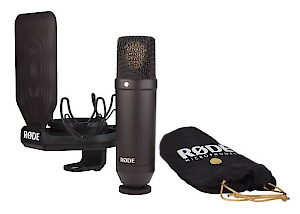The Rode Rodecaster Pro
Wow! I want. I want!
Join Dr. Bill as he examines the wild and wacky world of the web, computers, and all things geeky! Hot Tech Tips, Tech News, and Geek Culture are examined… with plenty of good humor as well!
Wow! I want. I want!
 By law, TV stations will be moving frequencies beginning in 2018 through at least the spring of 2020. To determine which stations in your area are moving and when, there is a service called TVAnswers.org. Check it out! You can see when you will need to “re-scan” your local stations as a Cord Cutter!
By law, TV stations will be moving frequencies beginning in 2018 through at least the spring of 2020. To determine which stations in your area are moving and when, there is a service called TVAnswers.org. Check it out! You can see when you will need to “re-scan” your local stations as a Cord Cutter!
There is a service called USATV247 (USA TV 24/7) that provides computer, tablet, and smartphone users the option to view certain channels free on the web. No account is required, and there is no charge. You simply go to the web site, and choose the channel that you want to see. Obviously, you can also Chromecast the computer screen to your HD TV as well, if you like.
 There is service that provides free streaming of local stations to some areas of the country. It is called Locast.org and is free. They do accept donations, and claim to be expanding their service. so, if you are having trouble with your local antenna, and live in these areas, this might be an option for you!
There is service that provides free streaming of local stations to some areas of the country. It is called Locast.org and is free. They do accept donations, and claim to be expanding their service. so, if you are having trouble with your local antenna, and live in these areas, this might be an option for you!
“Locast is a public service to Americans, providing local broadcast signals over the Internet in select cities. All you have to do is sign up online, provide your name and email address, and certify that you live in, and are logging on from, one of the select US cities (‘Designated Market Area’). Then, you can select among local broadcasters and stream your favorite local station.
Locast.org is a ‘digital translator,’ meaning that Locast.org operates just like a traditional broadcast translator service, except instead of using an over-the-air signal to boost a broadcaster’s reach, we stream the signal over the Internet to consumers located within select US cities.
Ever since the dawn of TV broadcasting in the mid-20th Century, non-profit organizations have provided ‘translator’ TV stations as a public service. Where a primary broadcaster cannot reach a receiver with a strong enough signal, the translator amplifies that signal with another transmitter, allowing consumers who otherwise could not get the over-the-air signal to receive important programming, including local news, weather and of course, sports. Locast.org provides the same public service, except instead of an over-the-air signal transmitter, we provide the local broadcast signal via online streaming.
You need a broadband Internet connection for optimal performance. Using a laptop, smartphone, or computer connected to the Internet, point your browser to www.Locast.org to sign up. You then can choose which local broadcast station to watch from your Internet-enabled device.”
 PBS is making noises that it might soon be open to putting their content on services like YouTubeTV and Hulu. This is a turnaround from the past, because they have said that so much of their content is owned by local PBS stations. The discussions with these local stations must be going well, because they have announced the potential of freer access in the future.
PBS is making noises that it might soon be open to putting their content on services like YouTubeTV and Hulu. This is a turnaround from the past, because they have said that so much of their content is owned by local PBS stations. The discussions with these local stations must be going well, because they have announced the potential of freer access in the future.
Today the Boston PBS station WGBH has confirmed that they will be launching on 1 to 2 live TV streaming providers this fall with more on the way. This comes from Jon Abbott, president and CEO of the WGBH Educational Foundation.
This is odd.
This tiny Bluetooth chip doesn’t need a battery because it harvests energy from the air
The Verge – By: Jon Porter – “The Internet of Things promises to connect billions of otherwise ordinary devices to the internet, but when each one needs to have its own battery, there’s a limit to how small or cheap they can become. A new paper-thin Bluetooth chip that’s able to operate entirely without a battery could be about to solve this problem. The postage stamp-sized chip from Wiliot is able to harvest energy from the ambient radio frequencies around us, such as Wi-Fi, Bluetooth, and cellular signals, and use them to power a Bluetooth-equipped ARM processor that can be connected to a variety of sensors.
Wiliot says that the size of the Bluetooth chip, combined with the lack of any battery, means it can be produced cheaply and mounted on almost anything. The company gives several potential use cases for the technology. For example, it could be embedded in consumer products to provide easy access to a digital manual when the original paper version is long lost, or it could be put on a clothing label and used to communicate the optimal settings to a washing machine.
However, the fact that it can also be combined with sensors raises more interesting possibilities. In addition to tracking items through a supply chain, a temperature sensor could also report when items get either too hot or too cold. Elsewhere, a pressure sensor could detect when a food container is empty and automatically order a replacement, thereby making so-called smart fridges truly smart.
Although a recent $30 million financing round means that Wiliot now counts on both Amazon and Samsung as investors, it will still be another year before its sensor tags are widely available. Wiliot says that it hopes to offer them as part of a limited release in 2019 before making then widely available in 2020.”
… was lame. Sorry, but it was. I didn’t see anything there, in all the reports I saw, that looked interesting. In fact, even Stephen Colbert wasn’t impressed, here’s his review:
 As you know, I am always looking for technical improvements for the netcast. This year, I am concentrating on the audio! So, after MUCH research, I have chosen the Rode NT-1 Microphone with the AI-1 pre-amp!
As you know, I am always looking for technical improvements for the netcast. This year, I am concentrating on the audio! So, after MUCH research, I have chosen the Rode NT-1 Microphone with the AI-1 pre-amp!
The NT1 is a revolutionary new 1″ diaphragm condenser microphone from RØDE.
Although the body of the new NT1 closely resembles the NT1-A, the microphone has been completely redesigned from the ground up, with the only shared component being the mesh grille.
RØDE’s design engineers approached the NT1 as a marriage of innovation and tradition, starting with the capsule which is a completely new design. Codenamed the HF6, it is the perfect example of RØDE’s fusion of artistic design approaches and cutting-edge manufacturing techniques, and features a sound signature reminiscent of the famous microphones of old while at the same time exhibiting extremely low noise.
It has been developed with a focus on detailed midrange response, coupled with silky smooth high frequencies, and warm, round, bass reproduction to make the NT1 an absolute standout in its class.
In another world-first for RØDE, the transducer itself is suspended inside the microphone using Rycote’s industry-leading Lyre system, minimizing external vibrations at the capsule level. The capsule is then married to high-grade electronics that have been designed to provide the lowest noise level of any studio microphone available. The NT1 is an incredibly quiet microphone, measuring only 4.5dBA of self-noise.
Its body is machined from 6061 aluminium and then nickel plated for resistance against corrosion. Finally it is coated in a durable, military-grade ceramic layer, using advanced electrostatic application techniques developed by RØDE to ensure an extremely hard wearing finish that is resistant to scratches or marks.
The NT1 is supplied with the revolutionary new RØDE SMR shock mount. Featuring a unique double-Lyre suspension system, the SMR enhances the existing superior vibration cancellation of Rycote’s Lyre system by using a smaller inner Lyre to act as a tensioning element. This maintains each Lyre in the neutral position where it is most efficient at cancelling vibration. The SMR’s removable all-metal pop filter is as effective as it is visually striking, providing an integrated solution for plosive protection that is easily washable and designed to last as long as the shock mount and microphone.
The NT1 is designed and made in Australia, and is covered by RØDE’s industry-leading 10 year warranty.
Here is a review by audio geek, Bandrew, on his “Podcastage” show:
I will have it in soon! I am jazzed! (Oh, and of course, I didn’t pay anywhere near full price!)
Check out this foldable phone! I don’t see any hinges. I am not sure exactly how they are doing this… but, I like it!
Podcast: Play in new window | Download (Duration: 25:11 — 524.9MB) | Embed
Subscribe: RSS
Google Chrome wins the browser wars! Chrome extensions will work on the new Edge (when it debuts,) IPVanish VPN deal, bogus Roku activation scam, a Roku rumor, Chromecast hack, China lands on the Moon’s dark side, Philo deal and Tablo for cord cutters! Go to www.DrBill.TV/VPN to get a great discount!
Links that pertain to this Netcast:
International Association of Internet Broadcasters
|
|
|
 |
 |
| Download M4V | Download WebM | Download MP3 | Download Ogg |
 |
 |